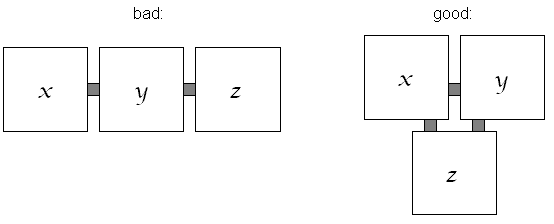Difference between revisions of "Fail-safe"
m (multiple vandalisms) |
|||
| Line 16: | Line 16: | ||
<strong>Example:</strong> The number and size of [[solar panel]]s is at least twice as big as actually needed for vital system operation. In normal operation mode the surplus energy can be used for additional convenience. | <strong>Example:</strong> The number and size of [[solar panel]]s is at least twice as big as actually needed for vital system operation. In normal operation mode the surplus energy can be used for additional convenience. | ||
| − | + | ==Interconnectivity== | |
| + | Services must be available, also in case of local failure. Therefore, the service providing systems are interconnected. | ||
| − | + | <strong>Example:</strong> If system A and system B have their own air supply system then people in building A can get air from building B in case of a failure in the air supply system of their own building. | |
| + | |||
| + | ==Grid instead of chain== | ||
| + | The whole system must be available independent from the failure location, even in catastrophic situations. The interconnection must allow normal functioning of the whole system even if one system part is completely destroyed. For the connection of more than two systems a grid is better than a chain. | ||
| + | |||
| + | [[Image:mesh.gif]] | ||
| + | |||
| + | The chain architecture (bad) bears the risk of a complete cut-off for system parts. The grid architecture (good) ensures a continuous interconnection of the remaining systems. | ||
| + | |||
| + | This applies for [[building]]s, as well. In the case of chain architecture, a drop in air pressure in building Y separates the people in X and Z. | ||
| + | |||
| + | <strong>Example:</strong> The [[Internet]] is (partially) constructed in a grid architecture. Despite the fact that it is the most complex artificial thing men have ever constructed it has never failed as a whole. | ||
| + | |||
| + | ==Backup systems== | ||
| + | A standby system is automatically powered up, or can be manually brought into operation shortly. Advantage: The system is not subject to full maintenance effort during standby mode. Risk: If not checked in regular intervals the backup system may not be able to work if needed. | ||
| + | |||
| + | |||
| + | [[category:concepts]] | ||
| + | [[category:technology]] | ||
| + | [[category:safety]] | ||
Revision as of 04:27, 20 May 2012
Due to the hostile environmental conditions on Mars, human visitors to the planet would have to rely heavily on artificial environments in order to survive. Their habitats' life support equipment must therefore run 100% reliably. This article describes the principles of fail-safe engineering.
The basic premise of fail-safe behaviour is to ensure that if a system or subsystem fails, it should do so in a "safe" manner; that is, no single failure should be able to place those who use or maintain it in danger.
The following systems are considered:
- Life support systems (oxygen, temperature)
- Production and storage of food
- Production, distribution and storage of energy
- Telecommunication network
- buildings
Redundancy
Every system is built twice or more, where each can work independent from the other. The capacity of each system is big enough to support the full service in case of failure of one system. In normal operation both systems are running in parallel with half load. This principle provides the best reliability for the whole function.
Example: The number and size of solar panels is at least twice as big as actually needed for vital system operation. In normal operation mode the surplus energy can be used for additional convenience.
Interconnectivity
Services must be available, also in case of local failure. Therefore, the service providing systems are interconnected.
Example: If system A and system B have their own air supply system then people in building A can get air from building B in case of a failure in the air supply system of their own building.
Grid instead of chain
The whole system must be available independent from the failure location, even in catastrophic situations. The interconnection must allow normal functioning of the whole system even if one system part is completely destroyed. For the connection of more than two systems a grid is better than a chain.
The chain architecture (bad) bears the risk of a complete cut-off for system parts. The grid architecture (good) ensures a continuous interconnection of the remaining systems.
This applies for buildings, as well. In the case of chain architecture, a drop in air pressure in building Y separates the people in X and Z.
Example: The Internet is (partially) constructed in a grid architecture. Despite the fact that it is the most complex artificial thing men have ever constructed it has never failed as a whole.
Backup systems
A standby system is automatically powered up, or can be manually brought into operation shortly. Advantage: The system is not subject to full maintenance effort during standby mode. Risk: If not checked in regular intervals the backup system may not be able to work if needed.







